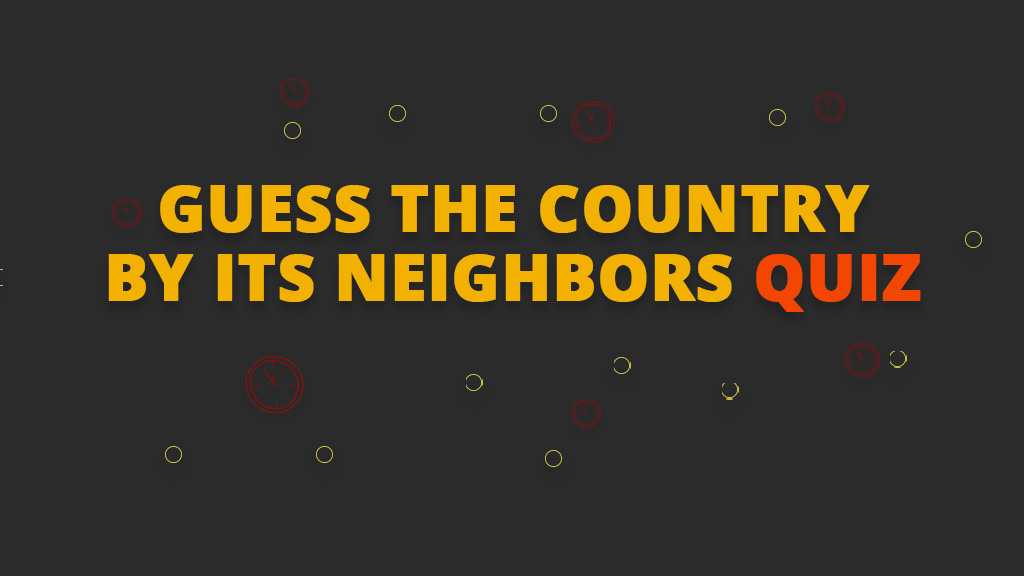❤️It's Trivia, but Sweeter❤️
Guess The Country By Its Neighbors Quiz

Guess the Country by Its Neighbors: A Geography Challenge
Geography is an exciting way to understand the world. It connects cultures, trade, and even history through borders shared by countries. One of the most engaging ways to test your geographical knowledge is by identifying countries based on their neighboring nations. This quiz brings you an opportunity to explore the relationships and proximity of countries while challenging your knowledge about global borders.
Why Is Geography Important?
Geography helps us comprehend the layout of the world, including its continents, countries, and major physical features. Knowing which countries border each other can significantly enhance our understanding of political, cultural, and economic interactions. Borders often determine relationships between nations, influence trade routes, and shape historical conflicts.
For example, the United States shares borders with Canada and Mexico, two crucial allies in trade and culture. Similarly, Switzerland is surrounded by countries like France, Germany, and Italy, making it a central player in European geopolitics.
This quiz highlights not only geographical knowledge but also the deeper connections and historical relevance of borders.
Understanding Borders
A border is more than just a dividing line; it’s a point of connection. Countries with shared borders often have overlapping histories, similar languages, and intertwined economies. For instance, countries in Europe have closely knit ties due to their proximity, leading to the European Union’s creation, which fosters economic and social integration.
On the other hand, borders in other regions, such as Africa or Asia, often represent remnants of colonial boundaries or natural divides like rivers, mountains, or deserts. These borders sometimes create unique challenges or opportunities for the countries involved.
Tips to Master Geography
If you’re preparing for quizzes like this or simply wish to improve your geographical skills, here are some tips to get started:
- Study Maps Regularly
Spend time studying world maps to familiarize yourself with countries, their shapes, and their relative locations. Pay attention to clusters of countries like the Baltic states (Latvia, Lithuania, and Estonia) or South Asia (India, Pakistan, Nepal, etc.). - Learn Regions
Break the world into smaller, manageable regions. For example, focus on South America, learning which countries border Brazil or Argentina. Once you’re confident with one region, move to the next. - Understand Historical Context
Borders often reflect historical events, such as wars or treaties. For instance, the separation of India and Pakistan in 1947 explains their shared yet contentious border. - Play Games and Puzzles
Geography-based games like trivia apps, crossword puzzles, and jigsaw maps can make learning fun and engaging. - Use Mnemonics
Create memory aids to help you remember specific border relationships. For example, you could remember “CAN” for Canada, the United States, and Mexico.
The Role of Neighboring Countries
Countries sharing borders often experience unique dynamics. This can range from strong partnerships and economic cooperation to disputes or conflicts. Neighboring nations frequently collaborate on trade, tourism, and infrastructure projects. However, they can also face challenges like immigration issues or territorial disputes.
Examples of Border Relationships
- United States, Canada, and Mexico
The North American Free Trade Agreement (NAFTA), now replaced by the United States-Mexico-Canada Agreement (USMCA), showcases the economic importance of borders in North America. Despite geographical proximity, each country maintains distinct cultural and political identities. - France, Germany, and Italy
Europe’s borders are steeped in history. France, Germany, and Italy, sharing borders with Switzerland, have significantly shaped European culture, politics, and economics. These nations collaborate through the European Union, making the region one of the most integrated in the world. - China, India, and Nepal
Asia’s borders, particularly in regions like the Himalayas, reflect both cooperation and tension. Nepal acts as a buffer state between two giants, China and India. This unique geographical positioning influences trade, tourism, and cultural exchanges. - Zimbabwe, South Africa, and Zambia
In southern Africa, shared borders often signify shared resources like the Zambezi River. Nations here also collaborate on environmental conservation and tourism, especially regarding natural wonders like Victoria Falls.
Fun Facts About Borders
Borders are full of intriguing stories and unique characteristics. Here are some fascinating border-related facts:
- Longest Border
The border between Canada and the United States is the longest in the world, stretching over 8,891 kilometers. - Smallest Neighboring Countries
In Europe, Monaco and France share a border that spans only about 5.47 kilometers. - Natural Borders
Many borders follow natural features like rivers and mountain ranges. For instance, the Andes Mountains form a natural border between Argentina and Chile. - Most Neighboring Countries
China and Russia share borders with 14 countries each, more than any other nation. - Divided Cities
Some cities straddle international borders. For example, Baarle is a town split between Belgium and the Netherlands.
Geography’s Role in Education
Teaching geography through quizzes not only boosts knowledge but also encourages critical thinking. Quizzes like “Guess the Country by Its Neighbors” enhance spatial awareness, problem-solving, and memory skills.
For instance, if you know that Nepal shares borders with China and India, you might infer its geographical location in the Himalayas. Similarly, understanding European borders helps students grasp historical events like World War II or the formation of the Schengen Area.
Challenges of Border Identification
Identifying countries by their neighbors isn’t always straightforward. Some nations, like island countries or those with only one neighbor, are easier to recognize. For example, Australia doesn’t share land borders, making it unique. Meanwhile, countries like Russia or Brazil, which share borders with many nations, require a deeper understanding of their geography.
Moreover, political changes, such as the dissolution of the Soviet Union or Yugoslavia, have altered global borders, adding complexity to modern geography.
Engaging Students Through Quizzes
Educational quizzes that challenge players to guess countries by their neighbors make learning geography exciting. These quizzes can be tailored to different levels of expertise, from beginner to advanced. They’re ideal for classrooms, family game nights, or even solo learning.
Conclusion
Geography is a vast and fascinating field that connects people and places. Understanding borders and their implications enriches our comprehension of the world. Quizzes like “Guess the Country by Its Neighbors” are not just fun; they’re educational tools that enhance our global awareness.
So, are you ready to take on the challenge and explore the connections that shape our world? Dive into the quiz and discover how much you truly know about the countries and their neighbors!



